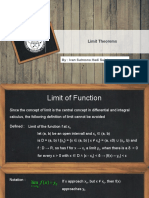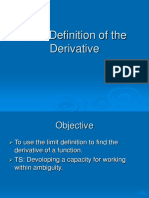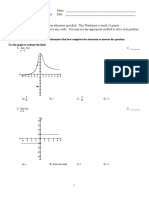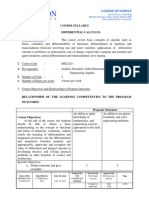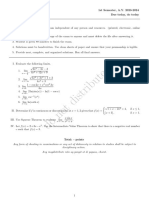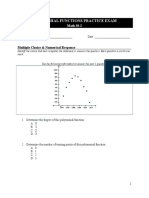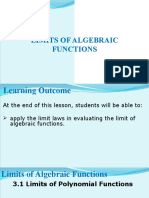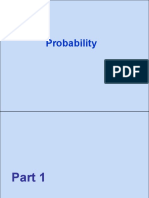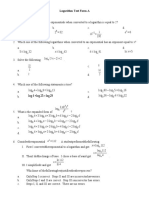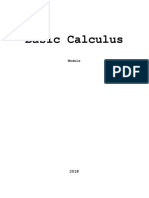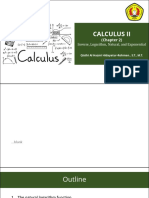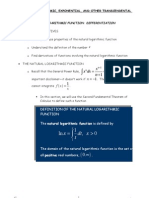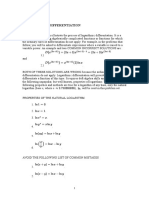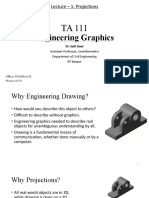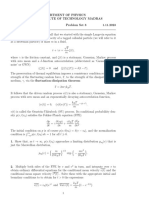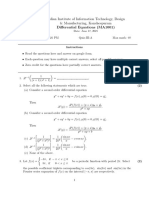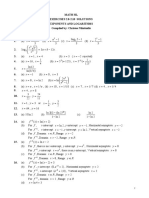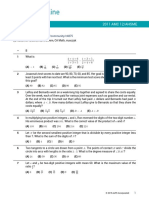CALCULUS 1
TRANSCENDENTAL FUNCTIONS
November 2016
�TRANSCENDENTAL FUNCTIONS
1. THE NATURAL LOGARITHM FUNCTION
2. INVERSE FUNCTIONS AND THEIR DERIVATIVES
3. THE NATURAL EXPONENTIAL FUNCTIONS
4. GENERAL EXPONENTIAL AND LOGARITHMIC
FUNCTIONS
5. THE INVERSE TRIGONOMETRIC FUNCTIONS AND
THEIR DERIVATIVES
6.THE HYPERBOLIC FUNCTIONS AND THEIR INVERSES
�THE NATURAL LOGARITHM
FUNCTION
�INTRODUCTIONS
x2
Dx
2
x 2
1
1
0
1
2
x , Dx x x , Dx ?? x , Dx x , Dx
x
1
Is there a function whose derivative is
x
1
Is there an antiderivatives dx ?
x
�Introductions
The Natural Logarithm function
�Derivative of the Natural Logarithm
Function
From the First Fundamental Theorem of Calculus, we have:
x
1
1
Dx dt Dx ln x
; x0
t
x
1
This can combined with the chain rule. If u=f(x) and if f is
differentiable, then :
1
Dx ln u Dx u
u
�Derivative of the Natural Logarithm
Function
EXEMPLE
1. Find Dx ln x
1
1 1 1/2
1
1/2
Dx ln x 1/2 Dx x 1/2 x
2x
x
x 2
2. Find Dx ln x 2 x 2
Dx ln x 2 x 2
1
2x 1
2
D
x
x
2
x x2
x2 x 2
�Derivative of the Natural Logarithm
Function
1
u du ln u c ; u 0
EXEMPLE
5
Find
2 x 7 dx
�Derivative of the Natural Logarithm
Function
EXEMPLE
3
x
dx
Find
2
1 10 x
�Derivative of the Natural Logarithm
Function
EXEMPLE
x x
x 1 dx
2
Find
�Properties of the Natural Logarithm
EXEMPLE
2
Find dy/dx if y ln 3 x 1 / x , x 1 ?
�Properties of the Natural Logarithm
y ln 3 x 1 / x 2
�Logarithmic Differentiation
Differentiate y
1 x2
x 1
2/3
�The Graph of the Natural Logarithm
�Trigonometric Integrals
EXEMPLE
1. Evaluate tan x dx
2. Evaluate sec x csc x dx
�EXERCISE 1
1. Find the derivative
Dx ln x 2 3x
Dx ln 3x 2
2. Find the integrals
1
a.
dx
2x 1
x
b. 2
dx
2x 8
3.Find dy/dx by logarithmic diffrentiation y
x2
c.
dx
x 1
x 11
x3 4
�INVERSE FUNCTIONS AND THEIR
DERIVATIVES
�Introductions
�EXISTENCE OF INVERSE FUNCTIONS (See. Before
Calculus)
�Existence of Inverse Functions
EXEMPLE
Show that f (x)= x5 + 2x + 1 has an inverse
SOLUTION
f (x) = 5x4+2 >0 for all x. Thus, f is increasing on the whole real
line and so it has an inverse.
�Existence of Inverse Functions
1. We do not claim that we can always give a formula for f -1
2. For the function that do not have inverses on their natural
domain, we simply restrict the domain to a set on which the
graph is either increasing or decreasing.
�Existence of Inverse Functions
If f has and inverse f -1 , the f -1 also has an inverse, namely, f.
�The Graph of y = f -1(x)
�Derivatives of Inverse Functions
�Derivatives of Inverse Functions
�EXERCISE 2
1. Show that f has an inverse
a. f ( x) x5 x3
b. f ( x) x 2 x 6 ; x 2
2. Find the formula for f -1(x)
x 1
a. f ( x) x 1
b. f ( x)
x 1
3. Find (f -1)(-2) by using theorem B.
3
f ( x) 3x 5 x 2
�QUIZ
1
1. Find the integrals a.
dx
1 2x
x4
b.
dx
x4
x3 x 2
c.
dx
x2
2. Find dy/dx by logarithmic diffrentiation y x 2 3x x 2 x 2 1
/3
3. Evaluate
tan x dx
0
4. Show that f has an inverse f ( ) cos ; 0
3
x
2
-1
f
(
x
)
5. Find the formula for f (x) :
x3 1
6. Find (f -1)(2) by using theorem B.
f ( x) x 5 5 x 4
�THE NATURAL EXPONENTIAL
FUNCTIONS
�Introduction
DEFINITION
The inverse of ln is called natural exponential function and is denoted
by exp. Thus,
x exp y y ln x
1. exp ln x x
x0
2. ln exp y y
for all y
�Properties of the Exponential Function
DEFINITION
The letter e denotes the unique positive real number such that ln e = 1
e 2.718281828459045
If r is rational number : er exp ln er exp r ln e exp r
e x exp x
1. exp ln x x
x0
2. ln exp y y
for all y
1. eln x x
x0
2. ln e y y
for all y
THEOREM
Let a and b be any real numbers. Then eaeb=ea+b and ea/eb=ea-b
�The Derivative of ex
The Derivative of ex :
Dx e x e x
If u=f(x) is differentiable, then the Chain Rule yields :
Dx eu eu Dx u
EXEMPLE
Find Dx e x
1
Dx e
e x Dx
e
x 1
x e . x 2
2
2 x
�The Derivative of ex
EXEMPLE
x ln x
D
e
Find x
2
�The Derivative of ex
The derivative formula Dxex = ex automatically yields the integral formula:
u
u
e
du
e
C
EXEMPLE
Evaluate e4 x dx
Evaluate
x e
2 x3
dx
�The Derivative of ex
EXEMPLE
3
Evaluate
xe
1
3 x 2
dx
�The Derivative of ex
EXEMPLE
1
x
Evaluate
6e
x 2 dx
�EXERCISE 3
1. Find Dxy
a. y e
2 x2 x
c. y e
x3 ln x
d . e x y 4 x y
b. y x3 e x
2. Find each integral
a. e
3 x 1
dx
b. e
x e x
dx
3. Find the volume of the solid generated by revolving the region
bounded by y=ex, y=0, x=0 and x=ln 3 about the x-axis
�GENERAL EXPONENTIAL AND
LOGARITHMIC FUNCTIONS
�Introduction
�Properties of ax
Proof
�Properties of ax
EXEMPLE
1. Find Dx 3 x
2. Find dy/dx if y x 2
4
x4 2
�Properties of ax
3. Find
2
2
x
dx
x3
�The Function loga
If 0 < a <1 then f(x) = ax is a decresing function ; If a >1, it is an
increasing function. In either case, f has an inverse .
We call this inverse the logarithmic function to the base a
�The Function loga
EXEMPLE
If y log10 x 4 13 find
dy
dx
�The Function ax, xa , and xx
Dx(xa) ???
a rational
a irrational ??
�The Function ax, xa , and xx
EXEMPLE
if y = xx , x >0, find Dxy by two different methods
�The Function ax, xa , and xx
EXEMPLE
2
1. If y x 1
2. If y x 1
2
sin x
sin x
dy
; find
dx
dy
; find
dx
�The Function ax, xa , and xx
51/ x
3. Evaluate 2 dx
1/2 x
1
�EXERCISE 4
1. Find the indicated derivative or integral
2 x 2 3 x
a. Dx 3
b. x 2 dx
x2
c. Dx log10 x3 9
d . 103 x 103 x dx
1
2. Find dy/dx
x
e
2 10
e x
a. y 10 x
b. y 2 2
2
�THE INVERSE TRIGONOMETRIC
FUNCTIONS AND THEIR
DERIVATIVES
�Introductions
Six basic trigonometric functions
1. sine
4. cotangent
2. cosine
5. secant
3. tangent
6. cosecant
�Inverse Sine and Inverse Cosine
�Inverse Sine and Inverse Cosine
�Inverse Tangent and Inverse Secant
�Inverse Tangent and Inverse Secant
�Four Useful Identities
�Derivatives of Trigonometric Functions
�Inverse Trigonometric Functions
�Inverse Trigonometric Functions
EXEMPLE
Find sin 1 3x 1
�Inverse Trigonometric Functions
�Inverse Trigonometric Functions
EXEMPLE
1
1. Evaluate
1
4 x
dx
�Inverse Trigonometric Functions
EXEMPLE
2. Evaluate
3
5 9x
dx
�Inverse Trigonometric Functions
EXEMPLE
ex
3. Evaluate
dx
2x
4 9e
�Inverse Trigonometric Functions
EXEMPLE
18
4. Evaluate
x
6
1
x 9
2
dx
�Manipulating the integral
EXEMPLE
7
dx
1. Evaluate x 2 6 x 25
�EXERCISE 5
�THE HYPERBOLIC FUNCTIONS
AND THEIR INVERSES
�DEFINITIONS OF HYPERBOLIC FUNCTIONS
DEFINITION
�GRAPHS OF THE HYPERBOLIC FUNCTIONS
�GRAPHS OF THE HYPERBOLIC FUNCTIONS
�HYPERBOLIC IDENTITIES
The most fundamental of these is
which can be proved by writing
�HYPERBOLIC IDENTITIES
�WHY THEY ARE CALLED HYPERBOLIC FUNCTIONS
�DERIVATIVE AND INTEGRAL FORMULAS
�DERIVATIVE AND INTEGRAL FORMULAS
�DERIVATIVE AND INTEGRAL FORMULAS
�DERIVATIVE AND INTEGRAL FORMULAS
�INVERSES OF HYPERBOLIC FUNCTIONS
�LOGARITHMIC FORMS OF INVERSE HYPERBOLIC
FUNCTIONS
The following relationships hold for all x in the domains of the
stated inverse hyperbolic functions
�PROPERTIES OF INVERSE HYPERBOLIC FUNCTIONS
�DERIVATIVES AND INTEGRALS INVOLVING INVERSE
HYPERBOLIC FUNCTIONS
�DERIVATIVES AND INTEGRALS INVOLVING INVERSE
HYPERBOLIC FUNCTIONS
�EXERCISE 6
1. Find Dxy
y sinh 2 x
y x 2 cosh x
y ln cosh 1 x
2. Evaluate each integral
a. sinh 3x 2 dx
b.
2
x
cosh
x
5 dx
3.Find the area of region bounded by y = cosh 2x, y = 0, x=-ln 5
and x=ln5





